You can see our other Nightmare on Elm Street lists here. Today, it’s time for Nightmare on Elm Street 3: Dream Warriors (1987), aka, the one where Freddy kills Nancy.
Although Elm Street 2 ended up grossing more than the first Elm Street, New Line was not happy with the artistic direction they had gone. Wes Craven had warned them their screenplay was crap. So, they brought him back to set things right. Then they threw out almost all of his ideas, and had two other guys take over for Nightmare on Elm Street 3. Suddenly, Freddy was funny, and the imagery far more fantastical and imaginative. Though that would ultimately undo the franchise as it would soon descend into regrettable camp, it was a stroke of brilliance at the time, delivering easily one of if not the best installments in the Nightmare on Elm Street series.
1. Why did Wes Craven come back?
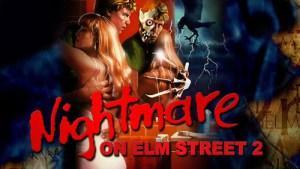
For starters, as would be their custom with every Nightmare on Elm Street film from Part 3 on New Line actually asked Craven if he was interested in coming back. He wasn’t available to direct because he was in the middle of pre-production on Deadly Friend, but he did take New Line up on their offer to write, officially co-writing Elm Street 3‘s script with his writing partner Bruce Wagner. His official, more artistic reason is, “I wanted to take it up to the next level. I felt like if I’m going to do another one I want it to be somehow better.” However, there’s really more of a cold, hard business side to it, about which he has said, “It was important for me in a business sense that I was able to negotiate a percentage point in the sequels I didn’t have from the original film.” New Line didn’t ask Craven back for Elm Street 2 because it would have meant having to negotiate some sort of profit sharing agreement, but by the time Elm Street 3 rolled around it was clear this had become the next great, lucrative horror franchise. The only way for Craven to get a piece of that action was to get back in bed with New Line.
2. Wes Craven’s original pitch was mostly what he ended up doing years later in New Nightmare
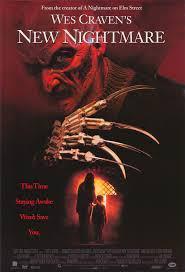
Pre-dating Kevin Williamson’s meta-cinematic masterpiece Scream by a couple of years, 1994′s Wes Craven’s New Nightmare was just a little too ahead of its time, alienating audiences with a Nightmare on Elm Street movie which was quite literally about the Nightmare on Elm Street movies. Its plot features Heather Langenkamp playing a fictionalized version of herself opting to return for another Elm Street film with Wes Craven as director only for Freddy to begin haunting their dreams, the fictionalized Freddy from the films turning out to have simply been containing a very real and far scarier dream demon of sorts.
However, if that was too much for audiences in 1994 what about 1987? Craven originally pitched the basic concept of Freddy invading the real world and haunting the actors and crew responsible for the Nightmare on Elm Street films for Elm Street 3. One imagine the New Line execs who rejected it at the time took a long pause, looked at each other, and then turned to Craven and said, “What else you got? Please tell us that wasn’t your only idea.”
3. Approximately 70% of Wes Craven’s original Dream Warriors screenplay was re-written because it was way too dark
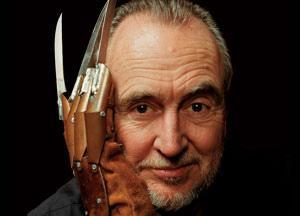
You devil
According to Craven, “We decided that it could no longer be one person fighting Freddy. It had to be a group, because the souls of Freddy’s victims have made Freddy stronger. I took an executive producing credit. My understanding was that I would be asked about things all along. I would be brought in to casting and have a real creative part in the picture. The reality was that New Line Cinema never really contacted me again after they had the script. They changed it quite drastically in some ways. The director (Chuck Russell) and a friend of his (Frank Darabont) rewrote it and changed the names of all the characters, and included several key scenes of their own.”
More written by Wagner than Craven, their Dream Warriors story was too dark (Nancy’s father cuts off his own eyelids in front of her during a dream in the opening scene), needlessly profane (Freddy threatens to shit on Nancy’s corpse), too expensive (the Freddy snake appears twice in the first 34 pages), and undisciplined (there’s no limit to Freddy’s powers). More than just that, it was also quite controversial, centering around the notion of children being compelled to travel to Freddy’s birth home and commit suicide, with dreams of Freddy being the common link between the victims. All of the teenagers at the Westin Hall hospital would only be there because they were among the few whose suicide attempts had failed. Russell and Darabont maintained some of the suicidal imagery, but they transplanted it to the dream world and added fantastical elements to soften the impact.
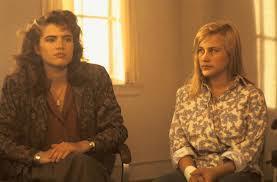
In the original script, Nancy was NOT a dream expert or mental health professional of any kind
There were various other changes to the Craven/Wagner script, Russell/Darabont turning African-American characters Caucasian, putting one character into a wheelchair, having Kristen stay in the institution for the whole story rather than leave halfway through, and sparing characters (Joey, Kincaid) Craven/Wagner originally killed. Significantly, the original concept would have Nancy searching for her father, who after the death of his wife/her mother at the end of the first Nightmare had become obsessed with finding and burning Freddy Krueger’s birth home (which was the dream image all of the suicidal kids were all drawn to). On this search, Nancy would kind of happen upon the psychiatric hospital, and be hired as an assistant due to her instant ability to connect with the troubled patients, such as finishing the Freddy nursery rhyme Kristen is singing (a scene which made it into the film almost completely unchanged).
You can actually read Craven/Wagner’s first draft as well as the Russell/Darabont script at NightmareOnElmStreetFilms.com.
4. The psychiatric hospital setting was inspired by real life institutions which claimed to be able to fix troubled teens
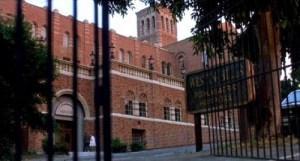
In Elm Street 1 and 3, there is a recurring theme of authority figures trying the best they can to help troubled teens but ultimately failing quite miserably. Related to that, according to Craven the idea for the mental health facility treating the Dream Warriors was not just some riff on One Flew Over the Cuckoo’s Nest but instead inspired by real life establishments, “At that time there was kind of a movement of such places that even advertised on television, ‘Send us your troubled child and we’ll make them okay.’ And, essentially, they were like prisons, or insane asylums.”
5. Ken Sagoes was cast as Kincaid because he cussed out the director
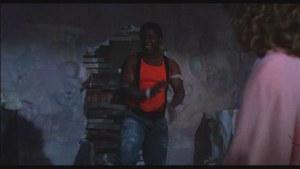
In the script, Kincaid is described as “enormous and powerful,” and the actor who eventually portrayed him (Ken Sagoes) didn’t think he fit the profile. However, his agent convinced him to audition, but on the day of the audition he had to walk through heavy rain to catch a bus meaning he showed up completely drenched. Then they made him wait for hours because they were behind schedule. So, when he finally got into the audition and the director told him, “Do whatever you want to,” Sagoes’ frustration boiled over. He told him, “Fuck you!” and cussed him out. They liked it so much they hired him.
6. That pig was real, and boy did it ever stink
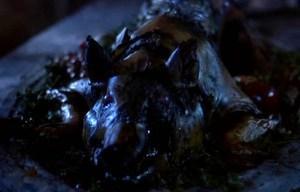
Kristen comes across a classic nightmarish image of a roasted pig on a table, and then it comes to life and growls at her. How’d they do that? They actually roasted a pig, let it spoil, and rop guys puppeted it from beneath. The poor guy who was actually behind the camera, cinematographer Roy H. Wagner, claims the pig stunk so much he can still smell it to this day.
7. “Welcome to Prime Time, Bitch!” was not a scripted line
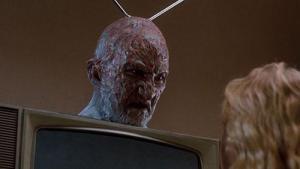
Elm Street 3 is really where the franchise took Freddy’s one-liners and ran with it, giving us one of his most memorable ones when bellows, “Welcome to Prime Time, Bitch!” before crushing Jennifer’s head through a TV. However, the actual scripted line was, “This is it Jennifer, your big break on TV!” Rogert Englund delivered it as scripted in the first couple of takes, but then improvised, “Welcome to Prime Time, Bitch!” Chuck Russell decided to use both the scripted and improvised lines, editing the two together.
8. Dick Cavett picked Zsa Zsa Gabor because she deserved to die
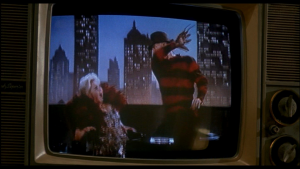
Well, maybe not “deserved to die.” However, for the dream sequence in which a Dick Cavett interview is interrupted by Freddy Krueger Cavett was actually allowed to pick the person he’d be interviewing. So, why’d he pick Zsa Zsa Gabor? Because he thought she was the dumbest person he’d ever met in his life, and he’d never have her on his show. So, if there was one person he’d want to see killed by Freddy it would be her. Daaaaaamn, who knew Cavett was so dark (and secretly awesome)?
9. The sex dream sequence was originally supposed to feature Freddy with breasts
If you are of a certain age there are specific film moments, mostly of the nude variety, which stick with you. Stacy Alden baring her breasts as Nurse Marcie in Dream Warriors is one such moment, and it made sense – you have teenage male characters, surely one of them is going to have a sex dream. However, while it turns into a nightmare for Joey when the nurse ties him to the bed with her tongue (S&M on a Elm Street level) it was originally meant to be a nightmare for viewers, with the nurse’s head turning into Freddy’s. So, you would have a topless Stacy Alden with a very convincing Freddy mask extending down to just above her breasts. A more confusing image you could not possibly imagine for a teenage boy in 1987.
10. The Freddy Snake originally looked like a giant penis
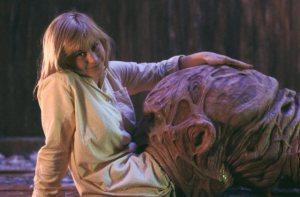
That’s a look that says, “Come on – we all know what this is.”
The “Freddy Snake” was originally pink, and basically looked like a giant penis swallowing Kristen whole. Some of the effects crew say this was intentional, others claim it was unintentional. Either way, once Chuck Russell saw it he was adamant that they could not film the puppet in that condition. He immediately instructed the set painters re-paint the puppet, adding in blues and greys, just anything to make it not quite so pink. However, they were pressed for time so they ultimately just covered it in a green goo.
The crisis was far from averted, though. Much like the prop shark from Jaws, the puppet, of which there were 3 different versions, didn’t quite work properly. So, they actually had to film the sequence backwards and play it in reverse. So, when Kristen is being swallowed by Freddy they started with her completely in the puppet and then slowly pulled the puppet off of her, playing it in reverse so it would like she was being swallowed.
11. Patricia Arquette’s first scene took 52 takes
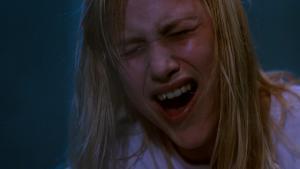
Chuck Russell was making his directorial debut with Dream Warriors, but the script he and Darabont delivered called for a $20 million budget to pull off the effects yet they only had $4.5 million. The result was an incredibly tense set. Also making her film debut was Patricia Arquette, but on her first day of filming they were so behind they didn’t get to her until 4 AM. She had forgotten her lines by then! They did 52 takes before they gave up on her remembering her lines. So, they fed her the lines via cue cards behind the camera.
12. Why did Nancy have to die?
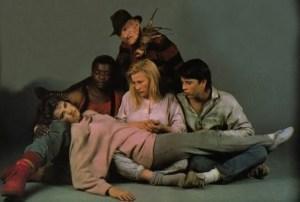
Nancy’s death was in Wes Craven’s original Dream Warriors screenplay meaning although most of the finished film had nothing to do with him he did get to kill off one of the characters he had created. So, why did he do it? Convention, mostly. If you survived the original and appeared in a sequel in a horror franchise you typically didn’t make it to the end of the sequel alive, partially because such a character potentially distracted from the true star – the killer. Plus, killing off Nancy raised the dramatic stakes because if she could die then all bets were off, as every single survivor of Dream Warriors would find out with their early deaths in Elm Street 4.
13. It was banned in Queensland, Australia until 1990

Even though the film was rated M15+ in other states of Australia, it was banned in Queensland due to its drug content until the Queensland Film Board of Review was abolished in 1990. You could still see it before 1990 – just not legally.
The final damage
- Body Count: 6 (5 by Freddy in dreams, 1 by Freddy’s bones real life
- Box Office: Dream Warriors was made for $4.5 million, and ultimately grossed $47.2 million, which would be like making $91.1 million at current ticket prices (that’s $10 million more than what Insidious: Chapter 2 did last year). Of the original Elm Street films, this makes Dream Warriors the second highest-grossing entry, behind only Elm Street 4. The first and second Elm Street films ended with $25 and $29 million respectively while Part 5 set a then franchise low with $22 million in 1989.
Next time, we’ll tell you why Patricia Arquette didn’t return for Nightmare on Elm Street 4: The Dream Master.
You can use the following links to check out all of our other “13 Things…” lists: Friday the 13th, Part 2, Part 3, The Final Chapter, A New Beginning, Jason Lives, New Blood, Jason Takes Manhattan, Jason Goes to Hell, Jason X, Nightmare on Elm Street, and Nightmare on Elm Street 2: Freddy’s Revenge.
Sources: Never Sleep Again: The Elm Street Legacy, NightmareOnElmStreetFilms.com, HorrorFanZine.com

